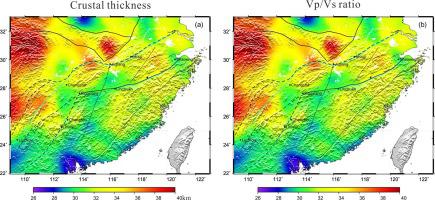Ore Geology Reviews ( IF 3.2 ) Pub Date : 2021-01-12 , DOI: 10.1016/j.oregeorev.2021.103988 Yongqian Zhang , Danian Shi , Qingtian Lü , Yao Xu , Zhiwu Xu , Jiayong Yan , Changxin Chen , Tao Xu

|
The eastern South China Block is characterized by multi-stage intra-continental collisions and orogeny from the Paleozoic to early Mesozoic, and strong magmatism and metallogenesis since the late Mesozoic. In order to further study the tectonics, magmatism and metallogenesis, we constructed a new model of crustal thickness and Vp/Vs ratio for the crust beneath the eastern South China Block using H-κ stacking of teleseismic P-wave radial receiver functions from 845 broadband seismic stations. New knowledge of the crustal structure and properties pertinent to the tectonics and metallogenesis is as follows: (1) the average crustal thickness beneath the eastern South China Block is 33 km. It is thinner and varies smoothly in the Cathaysia Block and Jiangnan Orogen, and gradually thickens to the northwest and reaches ~40 km in the Yangtze Block; (2) the average crustal Vp/Vs ratio of the eastern South China Block is ~1.72, lower than the global average value ~1.78. This implies an absence of a mafic lowermost crustal layer; (3) the Jiangnan Orogen is characterized by a conspicuous belt of lower Vp/Vs ratios, different from the Yangtze and Cathaysia Blocks on either side. This is interpreted as caused by synorogenic crustal thickening and the subsequent lower crustal delamination; (4) the crustal thickness and the Vp/Vs ratios in the eastern South China Block are negatively correlated, also indicating tectonic thickening of a felsic upper and middle crust. This is consistent with folding and thrusting during orogenesis and the later delamination of the mafic lower crust; (5) the Anhua-Luocheng fault is considered to be the southwestern segment of the boundary between the Yangtze Block and Jiangnan Orogen; (6) lithospheric extension caused by subduction of the Pacific Plate and the corresponding slab rollback during the late Mesozoic can explain the crustal thickness, the Vp/Vs ratio distribution patterns and the metallogenesis in the eastern South China Block.
中文翻译:

受接收器功能约束的华南东部地区地壳厚度和成分:对地质环境和成矿的意义
华南地块东部的特征是从古生代到中生代的多阶段陆内碰撞和造山作用,以及自中生代晚期以来的强烈岩浆作用和成矿作用。为了进一步研究构造,岩浆作用和成矿作用,我们利用来自845宽带的远震P波径向接收器函数的H-κ叠加,构造了一个华南地块下方地壳的地壳厚度和Vp / Vs比的新模型。地震台。有关构造和成矿作用的地壳结构和性质的新知识如下:(1)华南地块东部下方的平均地壳厚度为33 km。在华夏地块和江南造山带中,它较薄且变化平稳,并向西北逐渐增厚,在扬子区达到约40 km。(2)华南东部东部地区的平均地壳Vp / Vs比为〜1.72,低于全球平均值〜1.78。这意味着缺少铁镁质的最低地壳层;(3)江南造山带的特征是其Vp / Vs比值较低的明显带状带,不同于两侧的扬子和华夏地块。可以解释为这是由于地壳增生和随后的下地壳分层所致。(4)华南地块东部的地壳厚度与Vp / Vs比值呈负相关,也表明长英质上地壳和中地壳的构造增厚。这与造山过程中的褶皱和逆冲作用以及镁铁质下地壳的后期分层相一致。(5)安化—罗城断裂被认为是扬子地块与江南造山带边界的西南段;(6)中生代晚期太平洋板块俯冲引起的岩石圈扩张和相应的板块回滚可以解释华南地块东部的地壳厚度,Vp / Vs比例分布模式和成矿作用。











































 京公网安备 11010802027423号
京公网安备 11010802027423号